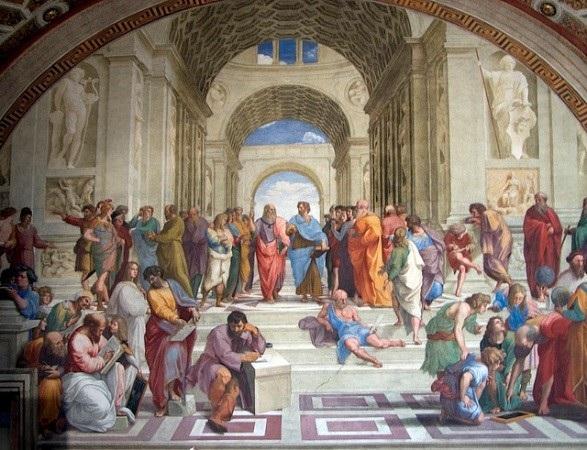School of Athens

Raphael was born in Urbino, Italy. His father, Giovanni Santi, was a painter to the Duke and somewhat of a poet. In the year 1501, Raphael was deemed a “master”, which meant that his training was complete. His first documented painting was also finished in this year. The painting was the Baronci altarpiece for the church of Saint Nicholas of Tolentino in Città di Castello.
After the commission by Pope Julius II in 1509, Raphael began painting the School Of Athens (Scuola di Atene). Raphael worked on the painting in the Apostolic Palace, located in Vatican City, Italy, where it has remained since the completion of the painting in 1510.
Considered by many, the most fascinating part of the painting are the individuals located inside the school house. Raphael depicted some of the most well renowned individuals in his painting, from great philosophers such as Aristotle and Plato, to genius mathematicians like Pythagoras and Ptolemy.
The two great thinkers, Aristotle and Plato, found in the very center have been enormously important to Western thinking in different ways, their different philosophies were incorporated into Christianity. Such ideas included The Golden mean, Reason, Logic, Biology, Passion, and Platonic realism
In this work of art, Plato is shown holding his book “The Timaeus”, a bible used to influence Christianity mostly in the form of a long monologue Plato himself wrote. Plato is also shown pointing up in referencing his philosophy that the changing world that we see around us is just a shadow of a higher reality that is eternal and unchanging. For Plato, this otherworldly reality is the ultimate reality.
Aristotle is seen holding his hand down this is referring to his philosophy that the only reality is the reality that we can see and experience by sight and touch. Aristotle’s Ethics “emphasized the relationships, justice, friendship, and government of the human world and the need to study it.”
The mathematician, Pythagoras believed that the world operated according to mathematical laws. These mathematical laws were related to ideas of musical and cosmic harmony, to God. Pythagoras taught that each of the planets produced a note as it moved, based on its distance from the earth. Together, the movement of all the planets was in perfect harmony.
Ptolemy holds a sphere of the earth, next to him is Zaroaster who holds a celestial sphere. The celestial sphere projection is a very practical tool for positional astronomy. Zoroaster is the name of the founder of Zoroastrianism, an early religion pitting good against evil that has influenced Judaism, Christianity, Islam, Gnosticism, and Buddhism. Ptolemy tried to mathematically explain the movements of the planets. His theory of how they all moved around the earth remained the authority until Copernicus and Kepler figured that the earth was not at the center of the universe, and that the planets moved in orbits the shape of ellipses not in circles.
The whole piece is full of such prodigies with inspiring history. They were the foundation for our future in science and mathematics. “If knowledge is power, then wisdom is life” stated Art Major Brian LaFrazia.
FSA Connection Questions
- Who believed that the world operated according to mathematical laws?
- Why does Aristotle hold his hands down?
- Why do you think these great men were painted in a school?
- When was this painted?
- Who did Raphael paint The School of Athens for? Why?
Your donation will support the student journalists of Freedom High School - FL. Your contribution will allow us to purchase equipment and cover our annual website hosting costs.




